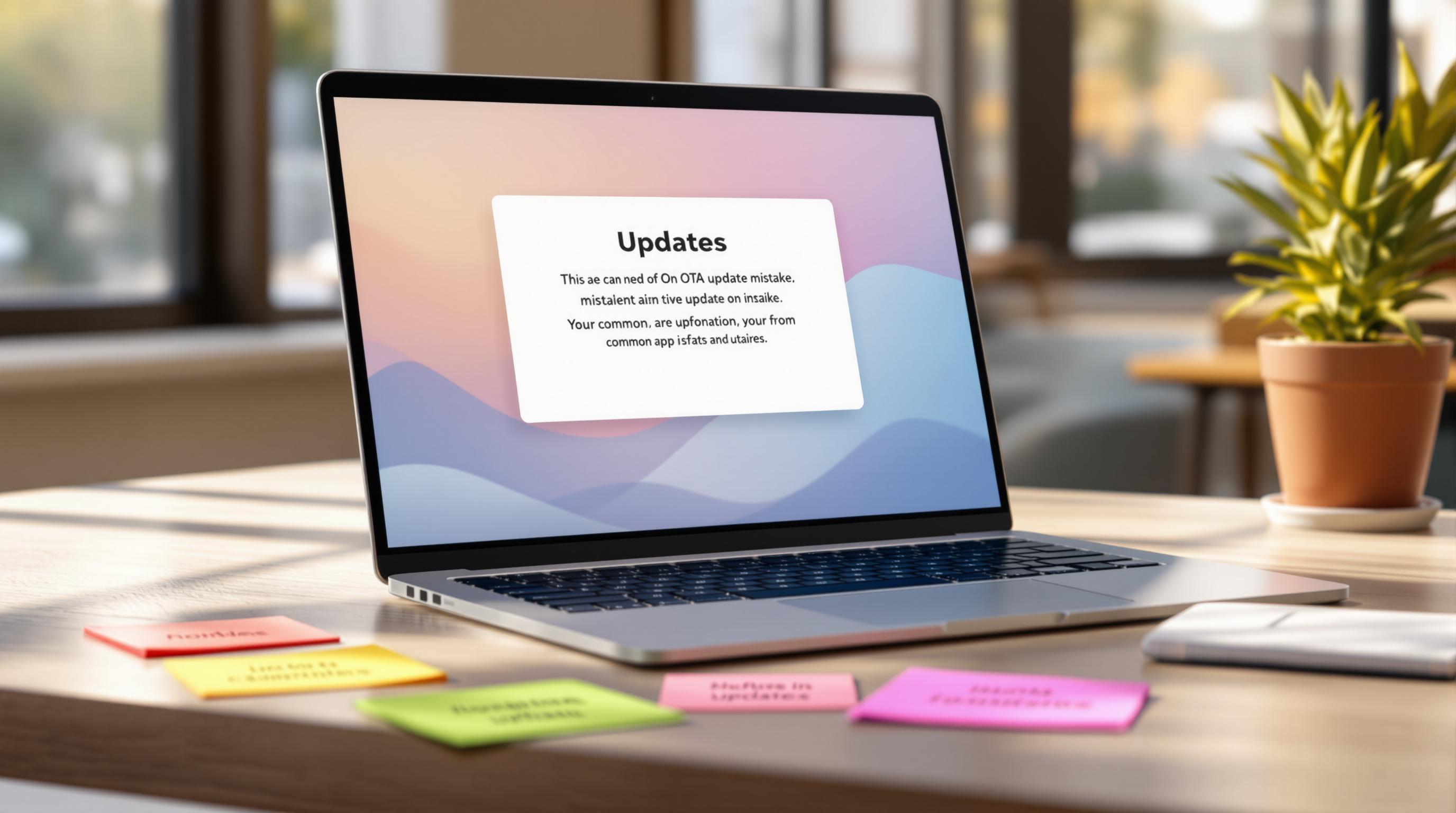Debugging Capacitor apps can be complex due to their hybrid nature, blending web and native technologies. This guide simplifies the process, covering essential tools, techniques, and tips to troubleshoot issues effectively.
Key Takeaways:
- Common Challenges: Platform-specific bugs and native plugin mismatches.
- Tools You Need:
- Web Debugging: Chrome DevTools, Safari Web Inspector.
- Native Debugging: Xcode for iOS, Android Studio for Android.
- Capacitor CLI: Commands like
npx cap doctorandnpx cap sync.
- Debugging Steps:
- Inspect web code with browser tools.
- Debug native components with platform-specific tools.
- Use verbose logging for plugin issues.
- Performance Optimization:
- Analyze network, memory, and UI performance.
- Leverage tools like Chrome DevTools and native profilers.
Quick Tips:
- Enable Source Maps: Debug original code instead of minified versions.
- Use Capgo for Updates: Push fixes instantly without app store delays.
- Set Up Error Tracking: Capture issues in real-time for faster resolutions.
This guide provides everything you need to identify and fix bugs, ensuring your Capacitor app runs smoothly across platforms.
The Ultimate Ionic Debugging Guide
Core Debugging Tools
Debugging Capacitor apps effectively requires the right tools. Here’s a breakdown of the essential debugging resources every Capacitor developer should know.
Web Debugging with Browser Tools
For debugging the web layer of Capacitor apps, Chrome DevTools and Safari Web Inspector are must-haves. These tools allow you to:
- Network Panel: Track API calls, resource loading, and network performance.
- Console: Catch JavaScript errors, view logs, and debug output.
- Elements Inspector: Inspect and modify DOM elements on the fly.
- Sources Panel: Set breakpoints and debug JavaScript execution.
Make sure to enable source maps - this lets you debug your original code instead of the minified production versions. For platform-specific issues, native debugging tools are the next step.
iOS and Android Debug Tools
When working on platform-specific problems, native debugging tools provide deeper insights into app behavior.
Xcode Debugging Tools (for iOS):
- Monitor memory usage.
- Profile CPU performance.
- Inspect network activity.
- Access device logs via the Console app.
Android Studio Tools (for Android):
- Use Logcat for system logs.
- Analyze UI with the Layout Inspector.
- Profile performance with the CPU Profiler.
- Track memory usage with the Memory Profiler.
These tools complement browser-based debugging by addressing platform-specific challenges.
Capacitor CLI Debug Commands

The Capacitor CLI includes helpful commands to streamline debugging:
npx cap doctor # Check your environment setupnpx cap sync # Sync web code with native projectsnpx cap open ios # Open iOS project in Xcodenpx cap open android # Open Android project in Android StudioFor live reload during development, use:
ionic cap run ios -l --external # Live reload for iOSionic cap run android -l --external # Live reload for AndroidTo troubleshoot plugin issues, enable verbose logging:
npx cap run ios --verboseThis outputs detailed logs about plugin initialization and native bridge communication, helping you pinpoint integration issues between web and native code.
Web and Native Debug Methods
Web Code Debugging Steps
To troubleshoot web components, leverage browser developer tools. These tools let you inspect elements, log messages to the console, monitor performance, and track network requests to pinpoint problems. Use source maps to trace errors back to the original code. If the issue involves native components, switch to debugging methods tailored to the platform.
Native Code Debug Steps
For iOS, rely on Xcode’s LLDB debugger. Set breakpoints in your Swift or Objective-C code to step through execution. Use Instruments to keep an eye on memory usage and thread activity. For Android, Android Studio provides robust tools, including native logging. Here’s an example:
Log.d("CapacitorApp", "Debug information");Log.e("CapacitorApp", "Error details", exception);These tools also simplify debugging for plugins when integrated into your workflow.
Plugin Debug Solutions
Verbose logging is key when debugging plugins. Pay attention to the following areas:
- Communication between the bridge and the plugin
- The implementation of specific methods
- How errors are propagated
Capgo’s error tracking tools can catch plugin problems early, preventing them from affecting users. You can also set up automated error reporting with code like this:
window.addEventListener('error', (event) => { console.error('Plugin Error:', { message: event.message, filename: event.filename, lineNo: event.lineno });});This approach ensures you catch and address issues efficiently.
Complex Debug Scenarios
App Launch Issues
Launch issues often happen before standard logging kicks in, making them tricky to diagnose. Here’s a step-by-step approach to handle them:
-
Check Native Logs: Use platform-specific tools like Xcode Console for iOS or Android Studio’s Logcat to uncover initialization errors. These logs often hold the first clues about what went wrong.
-
Track Plugin Errors: Monitor plugin loading problems with a simple listener. Here’s an example snippet:
App.addListener('pluginError', (info) => {console.error('Plugin failed to load:', info.pluginId);console.error('Error:', info.errorMessage);}); -
Inspect Resource Loading: Use browser developer tools to verify if essential resources are loading properly. Look for blocked requests or slow-loading assets and review timing metrics.
Once these initial checks are complete, you can move on to platform-specific debugging methods.
Platform-Specific Issues
Some bugs are tied to specific platforms, requiring tailored troubleshooting techniques.
For iOS debugging:
- Use Xcode’s Memory Graph Debugger to spot memory leaks.
- Test different network conditions with Network Link Conditioner.
- Add device-specific logging to catch iOS-specific crashes.
For Android debugging:
- Leverage Android Studio’s CPU Profiler to analyze performance.
- Enable strict mode to flag disk or network operations running on the main thread.
“We practice agile development and @Capgo is mission-critical in delivering continuously to our users!” – Rodrigo Mantica [2]
Performance Issues
After resolving launch and platform-specific problems, turn your attention to performance. Tackling performance issues involves focusing on three key areas: network, memory, and UI.
- Network Performance: Use Chrome DevTools to identify slow API responses or oversized payloads.
- Memory Management: Spot leaks with native profilers to ensure efficient memory usage.
- UI Optimization: Monitor frame rates and animations using built-in tools to ensure smooth user interactions.
Capgo’s error tracking tools make it easier to pinpoint these bottlenecks early. They also allow you to roll out fixes quickly, bypassing app store review delays [3].
Debug Guidelines
Effective debugging of a Capacitor app relies on well-structured logging, error monitoring, and source map management.
Setting Up App Logs
To debug effectively, use structured logs with defined levels to avoid unnecessary noise.
const logLevels = { ERROR: 0, WARN: 1, INFO: 2, DEBUG: 3 };
function logMessage(level, message, data = null) { const timestamp = new Date().toISOString(); const logData = { timestamp, level, message, data };
if (process.env.NODE_ENV === 'development') { console.log(JSON.stringify(logData)); }}In production, implement log rotation to prevent logs from growing uncontrollably:
const MAX_LOG_SIZE = 1024 * 1024; // 1MBconst MAX_LOG_FILES = 5;
function rotateLogFiles() { // Rotate logs to maintain up to 5 files of 1MB each}Besides logging, having a system to monitor errors in real time is essential.
Error Monitoring Setup
Set up a unified error tracking system that captures issues across both client and native layers.
window.onerror = function(message, source, lineno, colno, error) { logMessage(logLevels.ERROR, { message, source, line: lineno, column: colno, stack: error?.stack });
// Send error details to monitoring service return false;};Capgo’s error tracking tools can help monitor update deployments and assess their impact on users [1]. This integration provides crucial insights into update performance and user engagement.
“Detailed analytics and error tracking” – Capgo [1]
Source maps are another important tool to simplify debugging, especially for minified code.
Source Map Integration
Ensure your build process generates and manages source maps properly:
module.exports = { devtool: process.env.NODE_ENV === 'production' ? 'hidden-source-map' : 'eval-source-map', // ... other configuration settings};To make debugging even easier, automate source map uploads during deployment:
const uploadSourceMaps = async (buildId) => { const sourceMapFiles = await glob('dist/**/*.map');
for (const file of sourceMapFiles) { await uploadToDebugServer({ buildId, file, version: process.env.APP_VERSION }); }};If you use source maps in production, restrict access to authorized developers to maintain security while still allowing effective debugging.
Using Capgo for Quick Updates

Building on solid debugging techniques, tools like Capgo make it easier to keep your app stable by allowing instant updates. Capgo lets developers push updates without waiting for app store approvals, all while keeping debugging features intact.
Capgo Debug Features
Fixing issues quickly is key to maintaining app quality. Capgo offers real-time insights into app performance, helping resolve bugs efficiently. It boasts an 82% global success rate for updates, with 95% of users receiving updates within 24 hours [1].
Here’s a look at some of its standout features:
// Initialize Capgo error trackingimport { CapacitorUpdater } from '@capgo/capacitor-updater'
CapacitorUpdater.notifyListeners('download_failed', { version: '1.0.0', error: 'Network timeout'});Capgo also supports staged rollouts using a channel system, which is great for testing updates:
// Deploy update to beta channelasync function deployBetaFix() { await CapacitorUpdater.sync({ channel: 'beta', version: '1.0.1-beta' });}These tools can be seamlessly integrated into your workflow for smooth and efficient updates.
Adding Capgo to Your Debug Process
Getting started with Capgo is simple. Begin by initializing it with the following command:
npx @capgo/cli initHere’s how you can make the most of it:
-
Set up error monitoring
Add error tracking across both client and native layers to catch issues early:// Configure error monitoringconst setupErrorTracking = () => {CapacitorUpdater.addListener('updateFailed', (info) => {console.error('Update failed:', info);// Send error details to your tracking service});}; -
Deploy fixes incrementally
Use staged rollouts to test updates on smaller groups before a full release. -
Monitor update metrics
Keep an eye on key performance stats to ensure smooth updates:Metric Performance Update Delivery Speed 114ms for a 5MB bundle API Response Time 434ms worldwide User Update Rate 95% within 24 hours
Capgo’s partial update system only downloads changed files, reducing disruptions during debugging. With end-to-end encryption and compliance with app store guidelines, it’s a powerful tool for keeping your app stable and resolving issues quickly.
Summary
Tools and Methods Overview
Debugging effectively requires the right mix of tools and techniques. This guide covered essential methods that support a strong development workflow. Key tools include browser developer tools, platform-specific debuggers, and Capacitor CLI commands, all working together to pinpoint and fix issues quickly.
Pairing good debugging practices with live updates can greatly improve app stability. For instance, apps using these workflows report a 95% user update rate within 24 hours[1].
| Debug Component | Primary Function | Impact |
|---|---|---|
| Browser Tools | Inspect web code | Detect errors in real time |
| Platform Debuggers | Analyze native code | Resolve platform-specific issues |
| Error Monitoring | Track issues proactively | Achieves an 82% success rate globally[1] |
| Live Updates | Fix bugs instantly | Drives a 95% user update rate in 24 hours[1] |
Next Steps
You can enhance your debugging process by taking these steps:
- Set up error monitoring for both web and native layers to catch issues early.
- Use staged rollouts to test fixes before deploying them fully.
- Enable source maps to track errors more accurately.
- Integrate debugging tools into your CI/CD pipeline for smoother workflows.
“We practice agile development and @Capgo is mission-critical in delivering continuously to our users!” - Rodrigo Mantica[1]
Keep an eye on critical performance metrics to ensure your app runs smoothly.




